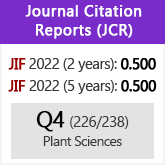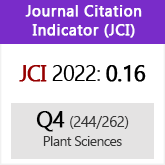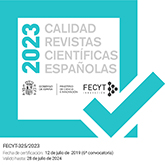The Madeiran laurel forest endemic Goodyera macrophylla (Orchidaceae) is related to American orchids
DOI:
https://doi.org/10.3989/ajbm.2605Keywords:
Biogeography, laurisilva, Macaronesia, orchids, phylogenyAbstract
Macaronesian laurel forests harbour many herbs and laurophyllous trees with Mediterranean/European or Macaronesian affinities. Traditionally, the origin of these taxa has been explained by the relict hypothesis interpreting these taxa as relics of formerly widespread laurel forests in the European continent and the Mediterranean. We analysed the phylogenetic relationships of the Madeiran laurel forest endemic Goodyera macrophylla (Orchidaceae) using sequences from the nuclear ribosomal DNA Internal Transcribed Spacers (ITS) and plastid DNA regions. The results were incongruent, either the two Central American G. brachyceras and G. striata (ITS) or the North American G. oblongifolia (plastid DNA) were sister group to G. macrophylla. Nonetheless, biogeographic analyses indicated an American origin of this nemoral laurel forest plant in the two data sets. Molecular clock analyses suggest a colonisation of Madeira in the span of the upper Miocene/lower Pliocene to the Pleistocene. Although the relict hypothesis cannot be ruled out by our data when assuming extinction events on the European and northern African mainland, dispersal from Central or North America to the archipelago of Madeira is a much more likely explanation of the data.
Downloads
References
Bateman R.M., Hollingsworth P.M., Preston J., Yi-Bo L., Pridgeon A.M. & Chase M.W. 2003. Molecular phylogenetics and evolution of Orchidinae and selected Habenariinae (Orchidaceae). Botanical Journal of the Linnean Society 142: 1-40. https://doi.org/10.1046/j.1095-8339.2003.00157.x
Capelo J., de Sequeira M.M., Jardim R., Mesquita S. & Costa J.C. 2005. The vegetation of Madeira Island (Portugal). A brief overview and excursion guide. Quercetea 7: 95-122.
Chen S.-P., Tian H.-Z., Guan Q.-X., Zhai J.-W., Zhang G.-Q., Chen L.-J., Liu Z.-J., Lan S.-R. & Li M.-H. 2019. Molecular systematics of Goodyerinae (Cranichideae, Orchidoideae, Orchidaceae) based on multiple nuclear and plastid regions. Molecular Phylogenetics and Evolution 139: 106542. https://doi.org/10.1016/j.ympev.2019.106542 PMid:31229601
Chen X., Lang K.-Y., Gale S., Cribb P. & Ormerod P. 2009. Goodyera. In Zheng-Yi W., Raven P. & De-Yuan H. (eds.), Flora of China: 45-54. Missouri Botanical Garden Press, Missouri.
Conran J.G., Bannister J.M. & Lee D.E. 2009. Earliest orchid macrofossils: Early Miocene Dendrobium and Earina (Orchidaceae: Epidendroideae) from New Zealand. American Journal of Botany 96: 466-474. https://doi.org/10.3732/ajb.0800269 PMid:21628202
Costa J.C., Capelo J., Jardim R., de Sequeira M.M., Espírito Santo D., Lousã M., Fontinha S., Aguiar C. & Rivas-Martinez S. 2004. Catálogo sintaxonómico e florístico das comunidades vegetais da Madeira e do Porto Santo. Quercetea 6: 61-185.
Dueck L.A., Aygoren D. & Cameron K.M. 2014. A molecular framework for understanding the phylogeny of Spiranthes (Orchidaceae), a cosmopolitan genus with a North American center of diversity. American Journal of Botany 101: 1551-1571. https://doi.org/10.3732/ajb.1400225 PMid:25253714
Drummond A.J., Suchard M.A., Xie D. & Rambaut A. 2012. Bayesian phylogenetics with BEAUti and the BEAST 1.7. Molecular Biology and Evolution 29: 1969-1973. https://doi.org/10.1093/molbev/mss075 PMid:22367748 PMCid:PMC3408070
Echeverría-Londoño S., Särkinen T., Fenton I.S., Purvis A. & Knapp S. 2020. Dynamism and context-dependency in diversification of the megadiverse plant genus Solanum (Solanaceae). Journal of Systematics and Evolution 58: 767-782. https://doi.org/10.1111/jse.12638
Ferguson D.K. 1974. On the taxonomy of recent and fossil species of Laurus (Lauraceae). Botanical Journal of the Linnean Society 68: 51-72. https://doi.org/10.1111/j.1095-8339.1974.tb01747.x
Fernández-Palacios J.M., de Nascimento L., Otto R., Delgado J.D., García-del-Rey E., Arévalo J.R. & Whittaker R.J. 2011. A reconstruction of Palaeo-Macaronesia, with particular reference to the long-term biogeography of the Atlantic island laurel forests. Journal of Biogeography 38: 226-246. https://doi.org/10.1111/j.1365-2699.2010.02427.x
Fernández-Palacios J.M., Arévalo J.R, Balguerías E., Barone R., Nascimento L., Delgado J., Elias R., Fernández-Lugo S., J, de Sequeira M.M., Naranjo-Cigala A. & Otto R. 2018. The Laurisilva. Canaries, Madeira and Azores. Macaronesia Editorial, Santa Cruz de Tenerife.
Figueira C., de Sequeira M.M., Vasconcelos R. & Prada S. 2013. Cloud water interception in the temperate laurel forest of Madeira Island. Hydrological Sciences Journal 58: 152-161. https://doi.org/10.1080/02626667.2012.742952
Fior S., Karis P.O. & Anderberg A.A. 2003. Phylogeny, taxonomy, and systematic position of Clethra (Clethraceae, Ericales) with notes on biogeography: evidence from plastid and nuclear DNA sequences. International Journal of Plant Sciences 164: 997-1006. https://doi.org/10.1086/378655
Frey G. & Pickering C. 1975. Contribution to the knowledge of the orchids of Madeira and the Azores. Bocagiana 38: 1-20.
Garay L.A. & Romero-González G.A. 1998. Schedulae Orchidum. Harvard Papers in Botany 3: 53-62.
García-Verdugo C., Caujapé-Castells J. & Sanmartín I. 2019. Colonization time on island settings: lessons from the Hawaiian and Canary Island floras. Botanical Journal of the Linnean Society 191: 155-163. https://doi.org/10.1093/botlinnean/boz044
Geldmacher J., Hoernle K., Klügel A., Wombacher F. & Berning B. 2006. Origin and geochemical evolution of the Madeira-Tore Rise (eastern North Atlantic). Journal of Geophysical Research 111: B09206. https://doi.org/10.1029/2005JB003931
Givnish T.J., Spalink D., Ames M., Lyon S.P., Hunter S.J., Zuluaga A., Iles W.J., Clements M.A., Arroyo M.T. & Leebens-Mack J. 2015. Orchid phylogenomics and multiple drivers of their extraordinary diversification. Proceedings Royal Society of London Series B Biological Sciences 282: 20151553. https://doi.org/10.1098/rspb.2015.1553 PMid:26311671 PMCid:PMC4571710
Góis-Marques C.A., MadeiraJ. & de Sequeira M.M. 2017. Inventory and review of the Mio-Pleistocene São Jorge flora (Madeira Island, Portugal): palaeoecological and biogeographical implications. Journal of Systematic Palaeontology 16: 159-177. https://doi.org/10.1080/14772019.2017.1282991
Góis-Marques C.A., de Nascimento L., Fernández-Palacios J.M., Madeira J. & de Sequeira M.M. 2019. Tracing insular woodiness in giant Daucus (s.l.) fruit fossils from the Early Pleistocene of Madeira Island (Portugal). Taxon 68: 1314-1320. https://doi.org/10.1002/tax.12175
Hileman L.C., Vasey M.C. & Parker V.T. 2001. Phylogeny and biogeography of the Arbutoideae (Ericaceae): Implications for the Madrean-Tethyan hypothesis. Systematic Botany 26: 131-143.
Hooker J.D. 1867. On insular floras. Gardeners' Chronicle 6-7, 27, 50-51, 75-76.
Hu C., Tian H., Li H., Hu A., Xing F., Bhattacharjee A., Hsu T., Kumar P. & Chung S. 2016. Phylogenetic analysis of a 'Jewel Orchid' Genus Goodyera (Orchidaceae) based on DNA Sequence Data from Nuclear and Plastid Regions. PloS one 11: e0150366. https://doi.org/10.1371/journal.pone.0150366 PMid:26927946 PMCid:PMC4771202
Huelsenbeck J.P. & Ronquist F. 2001. MRBAYES: Bayesian inference of phylogenetic trees. Bioinformatics 17: 754-755. https://doi.org/10.1093/bioinformatics/17.8.754 PMid:11524383
Iles W.J., Smith S.Y., Gandolfo M.A. & Graham S.W. 2015. Monocot fossils suitable for molecular dating analyses. Botanical Journal of the Linnean Society 178: 346-374. https://doi.org/10.1111/boj.12233
Katoh K., Misawa K., Kuma K.I. & Miyata T. 2002. MAFFT: a novel method for rapid multiple sequence alignment based on fast Fourier transform. Nucleic Acids Research 30: 3059-3066. https://doi.org/10.1093/nar/gkf436 PMid:12136088 PMCid:PMC135756
Kondraskov P., Schütz N., Schüßler C., de Sequeira M.M., Santos-Guerra A., Caujapé-Castells J., Jaén-Molina R., Marrero-Rodríguez Á., Koch M.A., Linder P., Kovar-Eder J. & Thiv M. 2015. Biogeography of Mediterranean Hotspot Biodiversity: Re-Evaluating the 'Tertiary Relict' Hypothesis of Macaronesian Laurel Forests. PloS one 10: p.e0132091. https://doi.org/10.1371/journal.pone.0132091 PMid:26173113 PMCid:PMC4501571
Kvaček Z. & Teodoridis V. 2007. Tertiary macrofloras of the Bohemian Massif: a review with correlations within Boreal and Central Europe. Bulletin of Geosciences 82: 383-408. https://doi.org/10.3140/bull.geosci.2007.04.383
Lowe R. 1831. Primitiæ faunæ et floræ Maderæ et Portus Sancti sive, Species quædam novæ vel hactenus minus rite cognitæ animalium et plantarum in his insulis degentium breviter descriptæ. Transactions of the Cambridge Philosophical Society 4: 1-70.
Maddison W. P. & Maddison D.R. 2021. Mesquite: a modular system for evolutionary analysis. Version 3.70. http://www.mesquiteproject.org.
Matzke N.J. 2013a. BioGeoBEARS: BioGeography with Bayesian (and Likelihood) Evolutionary Analysis in R Scripts. Website: http://CRAN.R-project.org/package=BioGeoBEARS. [accessed: 5 Oct. 2020].
Matzke N.J. 2013b. Probabilistic historical biogeography: new models for founder-event speciation, imperfect detection, and fossils allow improved accuracy and model-testing. Frontiers of Biogeography 5: 242-248. https://doi.org/10.21425/F5FBG19694
Mesquita S., Castel-Branco C. & de Sequeira M.M. 2020. Richard Thomas Lowe, an unknown Botanical Illustrator. Revista Scientia Insularum 3: 59-71. https://doi.org/10.25145/j.SI.2020.03.04
Pace M.C. 2020. A recircumscription of Goodyera (Orchidaceae), including the description of Paorchis gen. nov., and resurrection of Cionisaccus, Eucosia, and Salacistis. Brittonia 72: 257-267. https://doi.org/10.1007/s12228-020-09623-y
Panero J.L., Francisco-Ortega J., Jansen R.K. & Santos-Guerra A. 1999. Molecular evidence for multiple origins of woodiness and a New World biogeographic connection of the Macaronesian Island endemic Pericallis (Asteraceae: Senecioneae). Proceedings of the National Academy of Sciences 96: 13886-13891. https://doi.org/10.1073/pnas.96.24.13886 PMid:10570168 PMCid:PMC24160
POWO 2019. Plants of the World Online. Website: http://www.plantsoftheworldonline.org/. [accessed: 23 Sep. 2020].
Prada S., de Sequeira M.M., Figueira C. & Vasconcelos R. 2012. Cloud water interception in the high altitude tree heath forest (Erica arborea L.) of Paul da Serra Massif (Madeira, Portugal). Hydrological Processes 26: 202-212. https://doi.org/10.1002/hyp.8126
Press J.R. & Short M. 1994. Flora of Madeira. HMSO, London.
Rambaut A. & Drummond A.J. 2007. Tracer v1. 4. Website: https://beast.community/tracer [accessed: 15 Mar. 2020].
Ramírez S.R., Gravendeel B., Singer R.B., Marshall C.R. & Pierce N.E. 2007. Dating the origin of the Orchidaceae from a fossil orchid with its pollinator. Nature 448: 1042-1045. https://doi.org/10.1038/nature06039 PMid:17728756
Rankou H. 2011. Goodyera macrophylla. The IUCN Red List of Threatened Species 2011: e.T162070A5527443.
Ronquist F. & Huelsenbeck J.P. 2003. MrBayes 3: Bayesian phylogenetic inference under mixed models. Bioinformatics 19: 1572-1574. https://doi.org/10.1093/bioinformatics/btg180 PMid:12912839
Schlechter R. 1914. Die Orchidaceen von Deutsch-Neu-Guinea. Repertorium Specierum Novarum Regni Vegetabilis 1: 47-53.
Schüßler C. 2020. No Tertiary relicts? A biogeographical study on the Macaronesian laurel forest species in Daucus (Apiaceae), Geranium (Geraniaceae), Gesnouinia (Urticaceae), Phyllis (Rubiaceae), Semele (Asparagaceae) and Visnea (Pentaphylacaceae). Ph.D. dissertation, University of Heidelberg, Heidelberg.
Schüßler C., Bräuchler C., Reyes-Betancort J.A., Koch M.A. & Thiv M. 2019. Island biogeography of the Macaronesian Gesnouinia and Mediterranean Soleirolia (Parietarieae, Urticaceae) with implications for the evolution of insular woodiness. Taxon 68: 537-556. https://doi.org/10.1002/tax.12061
Shin K.-S., Shin Y.K., Kim J.-H. & Tae K.-H. 2002. Phylogeny of the genus Goodyera (Orchidaceae; Cranichideae) in Korea based on nuclear ribosomal DNA ITS region sequences. Journal of Plant Biology 45: 182. https://doi.org/10.1007/BF03030312
Spalik K., Piwczyński M., Danderson C.A., Kurzyna-Młynik R., Bone T.S. & Downie S.R. 2010. Amphitropic amphiantarctic disjunctions in Apiaceae subfamily Apioideae. Journal of Biogeography 37: 1977-1994. https://doi.org/10.1111/j.1365-2699.2010.02334.x
Stamatakis A. 2014. RAxML version 8: a tool for phylogenetic analysis and post-analysis of large phylogenies. Bioinformatics 30: 1312-1313. https://doi.org/10.1093/bioinformatics/btu033 PMid:24451623 PMCid:PMC3998144
Swenson U. & Manns U. 2003. Phylogeny of Pericallis (Asteraceae): a total evidence approach reappraising the double origin of woodiness. Taxon 52: 533-548. https://doi.org/10.2307/3647452
Valcárce V., Guzmán B., Medina N., Vargas P. & Wen J. 2017. Phylogenetic and paleobotanical evidence for late Miocene diversification of the Tertiary subtropical lineage of ivies (Hedera L., Araliaceae). BMC Evolutionary Biology 17: 1-14. https://doi.org/10.1186/s12862-017-0984-1 PMid:28641575 PMCid:PMC5480257
Williams B.R., Schaefer H., de Sequeira M.M., Reyes-Betancort J.A., Patiño J. & Carine M.A. 2015. Are there any widespread endemic flowering plant species in Macaronesia? Phylogeography of Ranunculus cortusifolius. American Journal of Botany 102: 1736-1746. https://doi.org/10.3732/ajb.1500238 PMid:26453597
Worobiec G. 2007. Laurus abchasica (Kolakovsky & Shakryl) Ferguson from the Neogene of the Belchatow Lignite Mine (Central Poland). Acta Palaeobotanica 47: 203-215.
Yu Y., Harris A.J., Blair C. & He X. 2015. RASP (Reconstruct Ancestral State in Phylogenies): a tool for historical biogeography. Molecular Phylogenetics and Evolution 87: 46-49. https://doi.org/10.1016/j.ympev.2015.03.008 PMid:25819445
Published
How to Cite
Issue
Section
License
Copyright (c) 2021 Consejo Superior de Investigaciones Científicas (CSIC)

This work is licensed under a Creative Commons Attribution 4.0 International License.
© CSIC. Manuscripts published in both the printed and online versions of this Journal are the property of Consejo Superior de Investigaciones Científicas, and quoting this source is a requirement for any partial or full reproduction.All contents of this electronic edition, except where otherwise noted, are distributed under a “Creative Commons Attribution 4.0 International” (CC BY 4.0) License. You may read here the basic information and the legal text of the license. The indication of the CC BY 4.0 License must be expressly stated in this way when necessary.
Self-archiving in repositories, personal webpages or similar, of any version other than the published by the Editor, is not allowed.

















